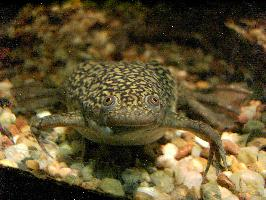
Váhy a míry
| Délka | od 8 do 15 cm |
|---|
Biologická data
| Délka života | od 5 do 15 let |
|---|
Popis zvířete
The African clawed frog, scientifically known as Xenopus laevis, is a unique amphibian species that has garnered significant interest from both scientific and pet-keeping communities around the world. Originating from the sub-Saharan regions of Africa, this species has adapted to a wide range of habitats, from arid to aquatic environments, demonstrating its remarkable versatility and resilience.Physical Characteristics
Xenopus laevis possesses a distinct appearance that sets it apart from other frog species. Adults can reach up to 12 centimeters (about 5 inches) in length, with females generally larger than their male counterparts. Their skin is smooth and slippery, varying in color from olive green to grayish-brown, often speckled with darker spots, which serves as camouflage in their natural aquatic habitats. One of the most notable features of this species is the presence of three short claws on each of their hind feet, a trait that gives the African clawed frog its name. These claws are not used for defense but rather for tearing apart their food.
Behavior and Ecology
African clawed frogs are fully aquatic, residing in warm, stagnant or slow-moving bodies of water such as rivers, lakes, and swamps. They are well adapted to their aquatic lifestyle, with their eyes and nostrils positioned on top of their heads, allowing them to breathe and watch for prey while remaining mostly submerged. They are voracious predators, feeding on a wide variety of prey, including insects, small fish, and even other frogs. Their method of feeding is quite unique; they use their sensitive fingers to detect and capture prey, then shove the food into their mouths using their forelimbs.
Reproduction
Xenopus laevis has a fascinating reproductive strategy. They are capable of breeding year-round in optimal conditions, with a preference for breeding after periods of heavy rain. The female lays hundreds, sometimes thousands, of eggs, which the male externally fertilizes. The eggs are adhesive and are often attached to vegetation in the water. Tadpoles emerge within a few days and undergo a relatively rapid metamorphosis, transforming into fully developed frogs within two to three months.
Scientific Importance
The African clawed frog holds a special place in scientific research, particularly in the fields of developmental biology and genetics. Due to their rapid development, ease of care in laboratory settings, and a particular sensitivity to thyroid hormones, which makes them an excellent model for studying embryonic development and endocrinology. Moreover, the species played a crucial role in medical research, including pregnancy tests in the mid-20th century, by injecting a woman's urine into the frog to induce egg laying if pregnancy hormones were present.
Conservation and Invasive Status
While Xenopus laevis is not currently listed as endangered in its native habitat, its introduction into foreign ecosystems has caused ecological disruptions. In areas where it has been introduced, often through the pet trade or from laboratory releases, it competes with native species for resources and preys upon local wildlife, thereby altering the balance of aquatic ecosystems. Consequently, it is considered an invasive species in several regions outside Africa.
In summary, the African clawed frog is a fascinating amphibian with distinctive physical and behavioral traits that have adapted it well to its natural environment and made it a valuable asset in scientific research. However, its resilience and adaptability also pose challenges when it is introduced into non-native habitats, highlighting the complex interplay between species and ecosystems.
Nové fotografie zvířat
Top 10 zvířat
- Chinese water dragon (Physignathus cocincinus)
- Galápagos tortoise (Geochelone nigra complex)
- Dolphin gull (Leucophaeus scoresbii)
- Japanese macaque (Macaca fuscata)
- Colombian red howler (Alouatta seniculus)
- Sea urchins (Echinoidea)
- Moustached guenon (Cercopithecus cephus)
- Diana monkey (Cercopithecus diana)
- Common reed warbler (Acrocephalus scirpaceus)
- Common house mosquito (Culex pipiens)